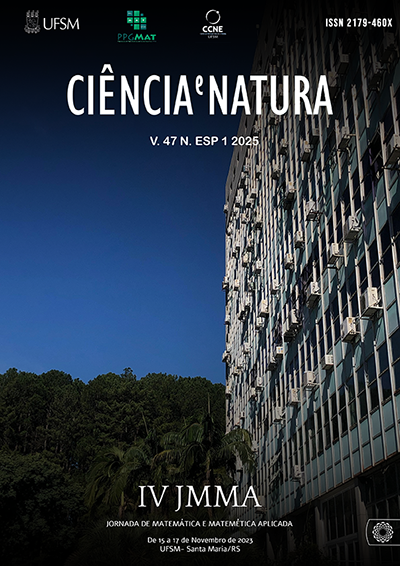Uma estratégia de regularização tipo level-set para a identificação de um coeficiente de rigidez constante por partes em uma viga
DOI:
https://doi.org/10.5902/2179460X90522Palavras-chave:
Regularização level-sets, Coeficiente de rigidez descontínuo, Vigas, Euler-BernoulliResumo
Neste trabalho, analisamos uma estratégia de regularização tipo level-sets para a identificação do coeficiente de rigidez constante por partes em uma viga do tipo Euler-Bernoulli estática, a partir de medidas indiretas da deflexão. Os resultados teóricos apresentados são ilustrados por algumas simulações numéricas.
Downloads
Referências
Brezis, H. (2010). Functional Analysis, Sobolev Spaces and Partial Differential Equations. Springer Science & Business Media. DOI: https://doi.org/10.1007/978-0-387-70914-7
Cezaro, A., Leit˜ao, A., & Tai, X.-C. (2009). On multiple level-set regularization methods for inverse problems. Inverse Problems, 25(3), 035004. Retrived from https://iopscience.iop.org/article/10.1088/0266–5611/25/3/035004. doi: 10.1088/0266–5611/25/3/035004. DOI: https://doi.org/10.1088/0266-5611/25/3/035004
Cezaro, A., Leit˜ao, A., & Tai, X.-C. (2013). On piecewise constant level-set (pcls) methods for the identication of discontinuous parameters in ill-posed problems. Inverse Problems, 29(1), 015003. DOI: https://doi.org/10.1088/0266-5611/29/1/015003
Evans, L. & Gariepy, R. (1992). Measure theory and fine properties of functions. (Studies in Advanced Mathematics). Boca Raton: CRC Press.
Gladwell, G. M. & Morassi, A. (2010). A family of isospectral Euler-Bernoulli beams. Inverse problems, 26(3), 035006. DOI: https://doi.org/10.1088/0266-5611/26/3/035006
Hibbeler, R. (2006). Resistˆencia dos Materiais. (7th ed.). Pearson Prentice Hall.
Kaltenbacher, B., Neubauer, A., & Scherzer, O. (2008). Iterative regularization methods for nonlinear ill-posed problems. (6th vol. Radon Series on Computational and Applied Mathematics). Berlin: Walter de Gruyter GmbH & Co. KG. DOI: https://doi.org/10.1515/9783110208276
Kawano, A. (2017). Uniqueness in the determination of unknown coefficients of an Euler-Bernoulli beam equation with observation in an arbitrary small interval of time. Journal of Mathematical Analysis and Applications, 452(1), 351–360. DOI: https://doi.org/10.1016/j.jmaa.2017.03.019
Kirsh, A. (2011). An introduction to the mathematical theory of inverse problems, volume (120th vol.). Springer Science & Business Media.
Lerma, A. & Hinestroza, D. (2017). Coefficient identification in the Euler-Bernoulli equation using regularization methods. Applied Math. Modelling, 41, 223–235. DOI: https://doi.org/10.1016/j.apm.2016.08.035
Lesnic, D., Elliott, L., & Ingham, D. (1999). Analysis of coefficient identification problems associated to the inverse Euler-Bernoulli beam theory. IMA Journal of Applied Mathematics, 62(2), 101–116. DOI: https://doi.org/10.1093/imamat/62.2.101
Marinov, T., Marinova, R., & Vatsala, A. (2015). Coefficient identification in Euler-Bernoulli equation from over-posed data. Neural, Parallel, and Scientific Computations, 23(2), 193–218.
Marinov, T. & Vatsala, A. (2008). Inverse problem for coefficient identification in the Euler-Bernoulli equation. Computers & Mathematics with Applications, 56(2), 400–410. DOI: https://doi.org/10.1016/j.camwa.2007.11.048
Medeiros, E. (2019). Identificação do coeficiente de rigidez no modelo de Euler-Bernoulli para vigas. (Master’s thesis). Universidade Federal do Rio Grande, Rio Grande, RS, Brazil.
Medeiros, E., Cezaro, A., & Cezaro, F. T. (2023). Uniqueness and regularization in the flexural stiffness coefficient identification problem for a statically determined Euler–Bernoulli beam. Communications in Nonlinear Science and Numerical Simulation, 126, 107486. DOI: https://doi.org/10.1016/j.cnsns.2023.107486
Medeiros, E., Cezaro, A., & Travessini de Cezaro, F. (2022). M´etodos iterativos de regularização para identificação do coeficiente de rigidez na equac¸ ˜ao de Euler-Bernoulli para vigas. Trends in Computational and Applied Mathematics, 23(2), 363–382. DOI: https://doi.org/10.5540/tcam.2022.023.02.00363
Downloads
Publicado
Como Citar
Edição
Seção
Licença
Copyright (c) 2025 Ciência e Natura

Este trabalho está licenciado sob uma licença Creative Commons Attribution-NonCommercial-ShareAlike 4.0 International License.
Para acessar a DECLARAÇÃO DE ORIGINALIDADE E EXCLUSIVIDADE E CESSÃO DE DIREITOS AUTORAIS clique aqui.
Diretrizes Éticas para Publicação de Revistas
A revista Ciência e Natura está empenhada em garantir a ética na publicação e na qualidade dos artigos.
A conformidade com padrões de comportamento ético é, portanto, esperada de todas as partes envolvidas: Autores, Editores e Revisores.
Em particular,
Autores: Os Autores devem apresentar uma discussão objetiva sobre a importância do trabalho de pesquisa, bem como detalhes e referências suficientes para permitir que outros reproduzam as experiências. Declarações fraudulentas ou intencionalmente incorretas constituem comportamento antiético e são inaceitáveis. Artigos de Revisão também devem ser objetivos, abrangentes e relatos precisos do estado da arte. Os Autores devem assegurar que seu trabalho é uma obra totalmente original, e se o trabalho e / ou palavras de outros têm sido utilizadas, isso tem sido devidamente reconhecido. O plágio em todas as suas formas constitui um comportamento publicitário não ético e é inaceitável. Submeter o mesmo manuscrito a mais de um jornal simultaneamente constitui um comportamento publicitário não ético e é inaceitável. Os Autores não devem submeter artigos que descrevam essencialmente a mesma pesquisa a mais de uma revista. O Autor correspondente deve garantir que haja um consenso total de todos os Co-autores na aprovação da versão final do artigo e sua submissão para publicação.
Editores: Os Editores devem avaliar manuscritos exclusivamente com base no seu mérito acadêmico. Um Editor não deve usar informações não publicadas na própria pesquisa do Editor sem o consentimento expresso por escrito do Autor. Os Editores devem tomar medidas de resposta razoável quando tiverem sido apresentadas queixas éticas relativas a um manuscrito submetido ou publicado.
Revisores: Todos os manuscritos recebidos para revisão devem ser tratados como documentos confidenciais. As informações ou ideias privilegiadas obtidas através da análise por pares devem ser mantidas confidenciais e não utilizadas para vantagens pessoais. As revisões devem ser conduzidas objetivamente e as observações devem ser formuladas claramente com argumentos de apoio, de modo que os Autores possam usá-los para melhorar o artigo. Qualquer Revisor selecionado que se sinta desqualificado para rever a pesquisa relatada em um manuscrito ou sabe que sua rápida revisão será impossível deve notificar o Editor e desculpar-se do processo de revisão. Os Revisores não devem considerar manuscritos nos quais tenham conflitos de interesse resultantes de relacionamentos ou conexões competitivas, colaborativas ou outras conexões com qualquer dos autores, empresas ou instituições conectadas aos documentos.






